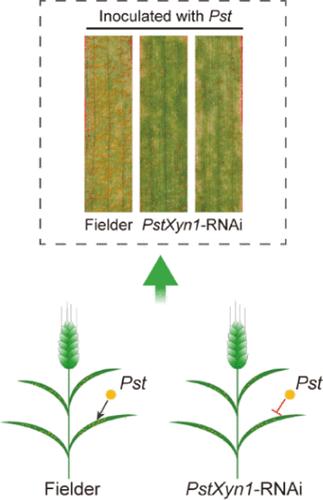分泌木聚糖酶PstXyn1可能通过克服细胞壁屏障和抑制防御反应参与小麦条锈病感染
IF 6.2
1区 农林科学
Q1 AGRICULTURE, MULTIDISCIPLINARY
引用次数: 0
摘要
小麦纹状锈菌(Pst)分泌大量的细胞壁降解酶(CWDEs)来促进真菌在感染过程中的入侵。然而,Pst中CWDEs的功能和分子机制尚不清楚。在这项研究中,我们发现了一个分泌木聚糖酶,命名为PstXyn1,具有GH10结构域。PstXyn1在Pst感染早期显著上调。PstXyn1的信号肽被证实是功能性的。纯化后的PstXyn1具有可检测的木聚糖酶活性。此外,我们发现沉默pstxyn1的小麦植株对多种Pst病型表现出广谱抗性。胶体金标记和转录组测序分析显示,PstXyn1参与宿主细胞壁木聚糖降解,抑制防御相关基因的表达。总之,我们的研究结果表明,PstXyn1作为一个重要的毒力因子分泌,克服宿主细胞壁屏障,损害真菌入侵的免疫反应,为提高小麦对条锈病的抗性提供了潜在的靶点。本文章由计算机程序翻译,如有差异,请以英文原文为准。

Secreted Xylanase PstXyn1 Contributes to Stripe Rust Infection Possibly by Overcoming Cell Wall Barrier and Suppressing Defense Responses in Wheat
Puccinia striiformis f. sp. tritici (Pst) secretes a plethora of cell wall-degrading enzymes (CWDEs) to facilitate fungal invasion during infection. However, the functions and molecular mechanisms of the CWDEs from Pst remain unclear. In this study, we identified a secreted xylanase, named PstXyn1, with the GH10 domain. PstXyn1 was significantly up-regulated at the early infection stage of Pst. The signal peptide of PstXyn1 was confirmed to be functional. The purified PstXyn1 showed detectable xylanase activity. In addition, we found that PstXyn1-silenced wheat plants exhibited broad-spectrum resistance against multiple Pst pathotypes. Colloidal gold labeling and transcriptome sequencing analyses revealed that PstXyn1 contributed to xylan degradation in host cell walls and suppressed the expression of defense-related genes. Conclusively, our results indicate that PstXyn1 is secreted as an important virulence factor to overcome host cell wall barriers and compromise immune responses for fungal invasion, providing potential targets for improving wheat resistance to stripe rust.
求助全文
通过发布文献求助,成功后即可免费获取论文全文。
去求助
来源期刊
CiteScore
9.90
自引率
8.20%
发文量
1375
审稿时长
2.3 months
期刊介绍:
The Journal of Agricultural and Food Chemistry publishes high-quality, cutting edge original research representing complete studies and research advances dealing with the chemistry and biochemistry of agriculture and food. The Journal also encourages papers with chemistry and/or biochemistry as a major component combined with biological/sensory/nutritional/toxicological evaluation related to agriculture and/or food.

 求助内容:
求助内容: 应助结果提醒方式:
应助结果提醒方式:


